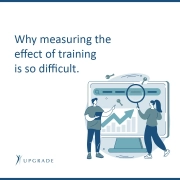Why measuring the effect of training is so difficult 📊
Why measuring the effect of training is so difficult:
Well…there are various influencing factors that have an impact on the effect of training.
Even in sales, “hard” indicators such as turnover or discounts granted are influenced by many variable factors, such as seasonal fluctuations, temporary supply or competition, and much more.
The difficulty therefore lies in establishing a clear link between the training carried out and the results achieved, which requires the use of appropriate analytical methods.
The legendary >> Four Level Model << by Kirkpatrick, developed in the early 1960s, is the origin of modern education control and is a proven model for evaluating the effectiveness of training measures.
It consists of the following four levels:
1 – Response
2️ – Learning
3️ – Behaviour
4️ – Results
But if we look at the training practice of companies today, almost nothing of this model seems to be in practice. In the majority of cases, they limit themselves to collecting feedback from the participants.
So what do you need to do?
You need a method that can make the actual training effects visible
We have combined various existing analysis tools into a targeted set of methods called Training Effectiveness Analysis (TEA). The core is a self-developed and software-supported before-and-after analysis.
The professional and sales dimensions measured can be defined individually for each company and each application, as can the depth of the analysis and the scope required.
We’d be happy to develop an individually tailored learning and development process for you and your team.
👉 Contact us!
⏩ www.upgradegroup.com/kontakt⏪
#BusinessDevelopment #ChangeManagement #TrainingProcesses #UPGRADETraining #SalesTraining #FourLevelModel



